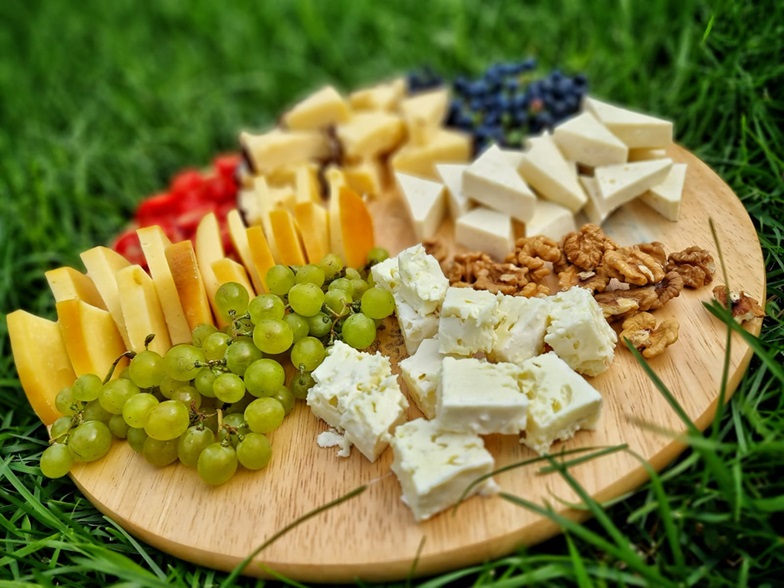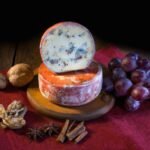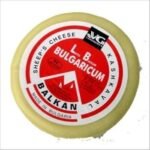The Burduf Cheese, indigenous to the Carpathian Mountains of Romania, is truly a valuable gem within the diverse world of cheese. Lauded for its rich and tangy flavor profile, the cheese boasts an intrinsic link to its geographical roots, offering an authentic taste of the country’s mountainous pastures. The true magic, however, lies in the traditional production method, which has been preserved meticulously over centuries.
Produced mainly from sheep’s milk but also from a mix of cow and sheep milk, Burduf cheese is distinctly known for its spherical shape, enclosed in a cover of pine bark. This unique method of storage infuses the cheese with a distinctive yet delicate pine flavor, along with lending to the cheese’s exceptional keeping qualities. The production process is labor-intensive and time-consuming: After the curdling of milk, the curd is hand-cut, boiled and then carefully pressed to expel whey. It is then salted and kneaded before being aged in the specially-prepared bark for at least three weeks. This meticulous process of traditional cheese-making defines the intense flavor of Burduf, making it a delicacy that’s sought after by cheese connoisseurs across the globe.
When it comes to tasting this mountain cheese, expect to find a soft and creamy texture, with a flavor that’s initially mild and buttery, gradually intensifying to reveal a tangy endnote. Its aroma is reminiscent of fresh rural pastures, with a slight hint of woody undertone, an echo of the pine bark it is kept in. Whether you’re pairing it with crusty bread and a glass of robust Romanian wine, or using it to enrich a traditional polenta dish – the Burduf cheese is bound to elevate your culinary experience.
Despite its age-old traditional making process, Burduf Cheese from Romania is not yet well-known outside of its home country, but is soon catching on as a must-try for any true cheese lover. The intrinsic connection to its geographical roots, combined with its distinctive taste and texture, sets this cheese apart as a unique addition to the world of artisanal cheese.
Welcome to our quiz on the topic of ‘Burduf cheese from Romania’! Discover how well you know this unique cheese variety, its history, preparation and cultural significance. Are you ready to challenge your knowledge and learn more about this distinctive cheese? Start now!

The Unique Tastes and Textures of Burduf Cheese from Romania
Burduf cheese, a distinct delicacy from Romania, is renowned for its exceptional and characteristic qualities that set it apart from other cheese varieties worldwide. This traditional cheese variety is crafted with extensive knowledge and application of local cheesemaking techniques dating back centuries, offering a textured culinary journey unique to Romania.
Recognizing Burduf cheese begins with the appearance, as it’s usually shaped into a spherical or cylindrical form. This creamy yellow cheese is typically wrapped in fir tree bark, giving it a rustic flavor profile that mirrors the evergreen landscapes of the Romanian highlands. The cheese also exhibits a slightly granulated texture that becomes smoother as it ages. Its taste is a complex blend of saltiness, slight acidity, and dynamic savoury-fruity notes, adding interest to every bite. Aroma wise, it emanates a rich, inviting, and distinctly sheep’s milk scent, just slightly tangy.
A proper Burduf cheese should meet the following quality properties:
- Texture: It should be semi-soft to firm, showing firmness that decreases with maturation.
- Taste: The cheese should have an intense, long-lasting, and rich flavor, often characterized as slightly piquant. It grows more complex and tangy with age.
- Appearance: A quality Burduf cheese should possess a creamy to pale yellow color, with a glossy texture thanks to its oil coating. The Bark wrapping should tightly cling to the cheese, enhancing its rustic character.
- Aroma: Genuine Burduf cheese has a unique rustic aroma, reminiscent of sheep’s milk, fragrant grasslands, and faint undertones of pine from the fir tree bark wrapping.
Every piece of Burduf cheese encapsulates the rich Romanian cheese-making heritage, highlighting the holistic commitment to meticulous craft and quality that transcends generations. For a true cheese connoisseur, the chance to taste genuine Burduf cheese is an opportunity to experience a gastronomic love letter to Romania’s culinary legacy.
Delving into Burduf Cheese: A Romanian Delicacy
A fabulous culinary revelation awaiting food connoisseurs is none other than Burduf cheese from the heart of Romania. A traditionally handcrafted cheese celebrated for its unique texture and pungent flavor, it’s considered a national specialty and is ingrained in the fabric of the country’s food culture.
Burduf cheese, or ‘Brânză de burduf’ as it is locally known, is a sheep’s milk cheese that speaks volumes about the quintessential flavors of Romanian pastoral tradition. This cheese is meticulously prepared by connoisseurs who carefully boil fresh sheep’s milk, then ferment it by employing a naturally occurring bacterium, Lactobacillus. The fermented curd is then separated, hand-kneaded, and pressed to remove any residual whey. The cheese mass is subsequently salted and left to mature for anywhere between 1-3 weeks in a natural casing made from sheep or cow’s stomach, known as ‘burduf’. This labor-intensive process conveys intense flavors and rich texture to the cheese.

Burduf cheese is distinguished by its crumbly texture and slightly hydroscopic properties. It develops a sharp tangy flavor and a powerful aroma that can be attributed to the unique aging process, making it a delightful addition to various Romanian dishes. The aromas can range from lightly acidic to intensely tarry, depending on the maturation duration and the specific characteristics of the natural casing used, thus bestowing upon each batch a unique identity.
Although similar cheese-making practices are prevalent in many cultures, the Burduf cheese of Romania stands out due to the following specific attributes:
- Rigorous artisanal production process sustaining the traditional methods
- Use of fresh, high-quality sheep’s milk
- Aging in a unique ‘burduf’ casing that intensifies the final flavor
Whether you experience it melted over polenta, in a classic sandwich, or as a standalone on a cheese platter, Burduf cheese promises a treat for your palate wrapped in layers of authentic Romanian tradition and culinary artistry.
- The cheese industry in Romania has a long tradition, with cheese production techniques passed down from generation to generation.
- Sheep farming plays a critical role in Romania’s agriculture, providing the milk for traditional cheeses like Burduf.
- As of 2020, Romania has four cheeses registered in the EU’s Protected Designations of Origin (PDO) list, including Burduf cheese.
- Burduf cheese production involves a unique maturation process in pine bark, a method used primarily in the Transylvania region.
- Despite its strong flavor, Burduf cheese is a common part of Romanian meals, often served with wine.
- The market for traditional Romanian cheeses like Burduf is growing, with increasing demand both nationally and internationally.
- Environmental factors such as the quality of the grass the sheep feed on affect the taste and quality of Burduf cheese.
Discovering the Authentic Taste of Burduf Cheese from the Heart of Romania
The taste of Burduf cheese is as rich and diverse as the land of its origin, Romania. This traditional cheese has been part of the Romanian culinary culture for centuries still prepared in the ancient ways that have been handed down through generations. The special taste of Burduf cheese owes much to the local, natural flora of the sheeps’ meadowland – a complex and delicate symphony of flavors.
Originating high in the Carpathian Mountains, Burduf cheese is a unique, soft cheese that captures the essence of the hillside pastures where the sheep graze. Made entirely from sheep’s milk, the cheese is machine or manually kneaded before being encased in a natural casing made from pine bark. The cheese is then aged for at least three months, developing a rich taste and aroma that is reminiscent of the pine forests of Romania.
The unique country and region of production make Burduf cheese a gastronomic treasure. It’s mainly produced in the Brasov, Covasna and Bacau counties, making the cheese very regional specific. The collection of the sheep’s milk that goes into this cheese is mostly done during May and September when the meadows are rich with a variety of vegetation. It’s this vegetation that directly contributes to the distinct taste and flavor of the Burduf cheese. However, it’s not just about the location. The defining aspects of Burduf cheese comes from:
- Good quality sheep’s milk
- Traditional cheese-making practices
- Ageing process and the use of pine or tree bark
The genuine Burduf cheese offers a unique bite that is tangy, slightly sharp but with a gentle smoky aftertaste due to its ageing process. This Balkan specialty is indeed an embodiment of its homeland – rich, complex and deeply rooted in tradition.
Discovering The Pleasure of Savoring Burduf Cheese from Romania
The culinary world of cheese is a vast, varied entity, and one of the hidden gems in this universe is Burduf cheese from Romania. Known for its potent flavor and unique method of aging in Bucharest, this stellar cheese often goes undervalued and unnoticed in the international cheese market. Made from sheep’s milk and traditionally stored in a sheep’s-stomach or in a skin of spruce bark, Burduf cheese is a versatile addition to your cheese board that offers a distinctive, slightly salty piquancy.
This amazing cheese boasts a soft and crumbly texture with a strong, somewhat sharp taste – the result of a traditional cheese-making process passed down through generations. Best enjoyed fresh, within a few weeks of its creation, Burduf cheese can be admired on its own or paired with the right accompaniments to bring out its exquisite richness.
Serving Burduf cheese in its prime requires a couple of thoughtful considerations. Here are a few tips:
- Have it at room temperature: The depth of flavor from Burduf cheese can be drowned if served too cold. Let it sit for an hour at room temperature before savoring the delicate nuances of its taste.
- Pair it with the perfect wine: A smooth, full-bodied red wine can complement the sheer intensity of Burduf cheese. Consider a robust Cabernet Sauvignon or a spicy Syrah to balance its robust flavor.
- Companion foods: Mild crackers, slices of tart apple or pear, and a hint of honey can beautifully accompany this cheese and elevate your gourmet experience.
Finding pairing companions for the flavorful Burduf can be a rewarding culinary journey. Remember, it’s all about finding a balance which complements, not overpowers, the intense flavor profile of this unique Romanian cheese. So, go ahead, create your own delightful gourmet adventure with the delectable Burduf cheese from Romania.
A Comprehensive Guide on Storing Burduf Cheese: Flourishing the Taste of Romanian Heritage
Burduf cheese, a traditional Romanian dairy product, is well-known for its distinctive, intensely savory flavor and semi-hard texture. In optimal storage conditions, this cheese type maintains its rich aroma and taste, which are primarily the outcome of a unique production process. Known as a “ball of cheese” due to its round shape, Burduf is prepared by mixing sheep’s milk cheese with a variety of herbs before stuffing it into a sheep’s stomach or into fir tree bark.
Proper storage is paramount in preserving the quality of Burduf cheese and ensuring its delightful characteristics remain unspoiled. The key to storing this cheese is to replicate the conditions of its traditional mountain production. Therefore, it is crucial to keep the cheese in a cool location, ideally between 3 – 4 Celsius degrees (roughly 37 – 39 Fahrenheit degrees). High humidity above 85% is also desirable to prevent the cheese from drying out. Wrapping the Burduf cheese in parchment paper before placing it in a sealable plastic container in the refrigerator will help to retain the right amount of moisture while preventing the cheese from absorbing the scent of other food items.
Moreover, Burduf cheese ought to breathe to maximize its flavor profile. Consequently, it is not advisable to vacuum-seal this cheese. Instead, let the cheese come to room temperature before serving so that it fully releases its unique aroma and taste. This is crucial as Burduf cheese develops a stronger flavor when it’s slightly warm. In case of leftover, it should be rewrapped in new parchment paper and stored similarly in the fridge.
Finally, it’s worth noting that Burduf cheese, when stored successfully, can last for several weeks. This makes it an excellent option for those looking for a long-lasting cheese that doesn’t compromise on flavor. However, always inspect the cheese visually and olfactorily before consumption. Mold build-up or a strong, unpleasant odor are indicative of spoilage and are telltale signs that the cheese should not be consumed.
Pairing Romanian Burduf Cheese with Perfect Wines
There’s something unique about Romanian Burduf cheese that tickles the taste buds of every gourmet, and rightly so. This traditional sheep’s milk cheese, known for its robust and slightly tangy profile, offers a distinctive gastronomic experience. The rich flavor is a result of its traditional aging process; the cheese is wrapped in fir tree bark, which imparts a unique resinous hint that adds to its overall composition. It’s easy to fall in love with Burduf cheese, more so when you pair it with the right wine to elevate the cheese’s complexity and deeply satisfying richness.
The first recommendation for pairing with Burduf cheese is a Romanian wine, the Feteasca Neagră. This is a full-bodied red wine known for its intense dark fruit flavors and subtle hints of spice. Its moderate acidity and light tannins work wonderfully against the strong and tangy flavors of the Burduf, creating a harmony of tastes on your palate. The wine’s dark fruit profile enhances the cheese’s natural creaminess, while the cheese, in turn, mellows down the wine’s spiciness, resulting in a truly enchanting gastronomic experience.
However, for those with a liking for white wines, the Crisp Sauvignon Blanc is a terrific choice. This wine, with its notes of green apple and lime, provides a bright, refreshing contrast to the cheese’s creamy and robust flavor profile. The optimal acidity present in this Sauvignon Blanc cuts through the cheese’s richness, whilst its green fruit undertones highlight the cheese’s slight tartness. It’s a tantalizing match that promises a delightful journey of unique tastes and textures.
Whether it’s the elegant Feteasca Neagră or the refreshing Crisp Sauvignon Blanc, the key to effortlessly enjoy the flavors of Burduf cheese lies in the perfect wine pairing. Ultimately, it’s the harmony between the two that make the consumption of this traditional Romanian cheese an unforgettable experience. Cheers to the perfect pair of wine and cheese!
Unearthing Culinary Wonders: Pairings for Burduf Cheese from Romania
Originating from the high pastures of the Carpathian Mountains, Burduf Cheese is one of Romania’s culinary treasures with a history hundreds of years old. Created by traditional sheepherders, this cheese, characterized by a semi-soft to hard texture and a strong, tangy flavor, is notably encased in a rustic pine bark which imbues an aromatic subtlety to the cheese. Burduf cheese is naturally high in protein, with a 50g serving providing about 7 grams, and fortified in calcium, making it not only a delectable delight but also a nutritious choice.
The complexity of Burduf cheese’s flavor profile allows it to harmonize with a diverse array of food and beverages. Its tangy taste chimes brilliantly with sweeter items, which counterbalance its potent power. One common pairing is with traditional Romanian condiments like raw onion or plum jam. The sharp flavor of the cheese juxtaposes harmoniously with the sweetness of the jam, creating a delightful fusion on the palate.
If you’re keen on pairing it with beverages, robust red wines work wonders with Burduf cheese. The combined boldness resonates, creating a vigorous flavor experience that excites the palate. Wines with a touch of sweetness like Merlot, or complex ones like Cabernet Sauvignon, pair exceptionally well with this Romanian cheese. Similarly, beers with a strong flavor profile such as IPAs or abbey-style ales, align beautifully with the richness of Burduf cheese.
Also worth considering is including Burduf cheese in recipes. It’s a welcome addition to traditional Polenta, imparting a distinctive burst of tangy flavor to the dish. Besides, it blends seamlessly in a variety of bread recipes, creating a rich, savorous treat. Here’s a brief guide to some possible pairings:
- Plum jam or raw onion condiments
- Red wines such as Merlot or Cabernet Sauvignon
- Strong beers like IPAs or abbey-style ales
- Traditional Romanian dishes such as Polenta or a variety of bread recipes
Whichever you choose, you’re sure to elevate your culinary experience with Burduf cheese’s robust and unique flavor.
Unearthing the Savory Traditions of Burduf Cheese from Romania
The nuances of Burduf cheese, a traditional delicacy in Romania, extend beyond its robust, deeply tangy flavor. This fascinating dairy product narrates a tale of ancient traditions, impressive skills, and unparalleled gastronomic delight that appeals to discerning cheese enthusiasts across the globe. Distinctively encased in a pine bark wrapper lending a pleasingly resinous note, this rich sheep’s milk cheese serves as an embodiment of mountainous Romania’s pristine pastures and a testament to its shepherding tradition.
Burduf cheese has its roots entrenched in the rural Transylvanian alpine highlands of Romania, where sheep rearing and cheese making have been integral aspects of the local lifestyle for centuries. Traditionally, Burduf cheese is handmade in small batches by skilled shepherds who maneuver through the labor-intensive process with incredible finesse. The process involves sheep’s milk curd being salted, kneaded, and pressed into small, round forms before it is aged in sheepskin or pine bark for optimum flavor enhancement.
- The salted curd yields a crumbly yet creamy cheese with a tangy and slightly pungent flavor profile, highlighting the quality of sheep’s milk used in its production.
- The aging process within sheepskin or pine bark imbues the cheese with a delicate, smoky hint and a subtle resinous undertone, which complements its primary robust flavor remarkably well.
Interestingly, Burduf cheese’s versatility extends to both fresh and aged forms. While the fresh Burduf cheese is soft, mildly sour and consumed pronto, the aged Burduf develops a stronger flavor profile, a crumblier texture, and progressively becomes sharper with time. This highlights its adaptability, as it can be served either as a creamy spread over a loaf of crusty bread or grated over hearty staple foods like polenta. With every morsel, Burduf cheese brings an experience that connects the consumer with the rich pastoral traditions of its homeland, where each cheese batch tells its own unique, mouth-watering story.
Exploring the Intriguing Flavors of Burduf Cheese and its Complements
As a cheese aficionado, you must have heard about or have had the opportunity to taste the rich, salty taste of Burduf, which is one of Romania’s traditional types of cheese. It’s easily distinguishable due to its unique preparation and preservation in a sheep stomach or skin, which enhances the flavor and extends durability. Produced primarily in the Carpathian Mountains, Burduf cheese is often made from sheep’s milk and sometimes a mix of cattle and sheep milk.
The palatable process starts with curdling fresh milk using rennet, a natural enzyme found in young animal stomachs. After heating and pressing the curd to remove Whey liquid, the cheese is packed into a sheep’s skin and aged for about one to three months. This fermentation process offers Burduf cheese its potent scented and distinctive salty taste that is prized among cheese enthusiasts worldwide. Notably, the peculiar aged cheese is often soft, with a crumbly texture that makes it ideal for spreading on pieces of bread or as a topping to various dishes.
While there’s ample cheese variety globally, some bear similarity to Burduf cheese in taste, texture, and even preparation. Such include:
- Pecorino Romano: This Italian cheese shares a striking flavor profile with Burduf and also shows strong, sharp, and slightly abrasive, salty notes, much like Burduf. It is made from sheep’s milk and adds a touch of liveliness to pasta, bread, and casseroles.
- Feta: Hailing from Greece, Feta cheese despite having a softer texture and a tangier taste, bears a salty quality common to Burduf. It is often used as a table cheese or sprinkled atop salads, pasta, and pies to enrich flavor.
Whether you’re new to the cheese world or a seasoned taster, Burduf cheese and its counterparts can elevate your culinary experience, expanding the horizons of your palette. Appreciating and understanding the subtle and not-very-subtle variations among these cheese types can, in turn, deepen your appreciation for artisanal cheese-making.



